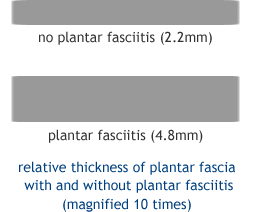Plantar Fasciitis Patients Have Thick Soles
There’s a connection between plantar fasciitis and a surprisingly thick tissue in the arch of the foot
When you are frustrated with a chronic condition like endless foot pain, sometimes you start to second-guess whether you really have what you think you have. Uncertainty about the diagnosis can be almost as frustrating as the pain itself. In fact, there’s excellent evidence (and it just makes sense) that feeling more confident about the nature of pain can reduce pain.1
Sometimes there’s no way out of that uncertainty … and sometimes there is.
Eureka! Unusually clear plantar fasciitis science

By 2012, several studies had shown that, yes, the sole of your foot really is thicker — a lot thicker — when you have plantar fasciitis.234 A 2012 study confirmed that using ultrasound to detect this is reliable: different technicians will get the same results.5 A 2014 meta-analysis reviewed all these (and more) and it concluded:6
Ultrasound can be considered a reliable imaging technique for assessing plantar fascia thickness, monitoring the effect of different interventions and guiding therapeutic interventions in patients with plantar fasciitis.
Such decisive conclusions are refreshing in musculoskeletal medicine, which is usually murkier. Many such correlations are clinically meaningless, and the reliability of a lot of testing is amazingly poor.7 This is a noteworthy case of firm ground! (Interpretation and implications, not so much — see below.)
The evidence also shows a connection between the thickening and flat feet.8 Flat feet, thick soles, and plantar fasciitis all tend to go together. Interesting.
So, if you have plantar fasciitis, chances are good that your plantar fascia is more than twice as thick as it should be: a nice clear physical sign that can be diagnosed with ultrasonography. (Not by feel, mind you.9) If you’d like to confirm this, all you have to do is bring it to your doctor’s attention and request ultrasound confirmation that you have “thick feet.” If your doctor is skeptical, show them the footnotes!
EXCERPT This short article is an excerpt of PainScience.com’s ridiculously detailed tutorial about plantar fasciitis.
What does it all mean? Interpreting a thick plantar fascia
This evidence does not show anything about causation. The research has not confirmed that a thickened plantar fascia causes plantar fasciitis — just that they definitely tend to occur together.
It’s quite plausible that the thickened fascia is a symptom of the condition. That is, excessive loading on the arch builds up the tissue, much like a callous. Or the thickening could be, counterintuitively, a sign of weakness, thicker but not necessarily stronger— an abnormal plantar fascia that can’t handle the load.10
Thicker fascia doesn’t necessarily mean you’re in bigger trouble (and thinner fascia doesn’t necessarily mean you’re in less)
The thickness might correlate with the severity of your case, or it might not. A 2018 study tested two different therapies while also considering plantar fascia thickness. Basically they wanted to know if thicker fascia made the condition harder to treat. They expected it to be, but it was not. Surprise!11 Some people with the thickest fascia did well, and some with thinner fascia did poorly. And more thinning in response to treatment didn’t always lead to the best outcomes.
So plantar fascia thickness is only diagnostic (at best), definitely not prognostic. People with plantar fasciitis definitely tend to have thicker soles, but that’s it: it doesn’t mean anything else.
Other benefits of diagnostic ultrasound
Examining your foot with ultrasound might turn up some other obvious cause of your pain — something interesting, other than a thickened plantar fascia. But take this with a grain of salt. Good scientific evidence has confirmed a strong correlation between thickened fascia and plantar fasciitis. But, as already discussed, other seemingly obvious issues like heel spurs do not necessarily explain anything!
For instance, we know that you can’t use X-ray and the presence of heel spurs in quite the same way to confirm your plantar fasciitis diagnosis, because heel spurs are often found in people with plantar fasciitis, but lots of people have heels spurs without plantar fasciitis. So, knowing that you have heel spurs alone doesn’t tell you all that much. If you have pain on the bottom of your foot and heel spurs and a thickened fascia confirmed by ultrasound … then, hoo boy, you’ve got a lot wrong with your foot, and a plantar fasciitis diagnosis is probably correct … but possibly not the only cause of pain.
For much (much much much) more information, see my advanced tutorial covering pretty much every imaginable thing about dealing with the condition:
About Paul Ingraham

I am a science writer in Vancouver, Canada. I was a Registered Massage Therapist for a decade and the assistant editor of ScienceBasedMedicine.org for several years. I’ve had many injuries as a runner and ultimate player, and I’ve been a chronic pain patient myself since 2015. Full bio. See you on Facebook or Twitter., or subscribe:
Related Reading
- Baxter’s Neuritis versus Plantar Fasciitis — A rare nerve entrapment that can explain some stubborn cases of “plantar fasciitis”
- Guide to Repetitive Strain Injuries — Five surprising and important ideas about repetitive strain injuries for patients and professionals
- Massage Therapy for Tired Feet (and Plantar Fasciitis!) — Perfect Spot No. 10, in the arch muscles of the foot
- Is Running on Pavement Risky? — Hard-surface running might be a risk factor for running injuries like patellofemoral pain, IT band syndrome, shin splints, and plantar fasciitis
What’s new in this article?
2020 — Science update: Discussed some interesting new data on the clinical relevance of plantar fasciitis thickness. Do thicker soles mean you’re in worse trouble? Probably not.
2007 — Publication.
Notes
- Modern pain science shows that pain is an extremely unpredictable sensation, heavily tuned by the brain and jostled by complex variables — not the relatively simple response to tissue insult that we tend to assume, and that most treatment is based on. For more information, see Pain is Weird: Pain science reveals a volatile, misleading sensation that comes entirely from an overprotective brain, not our tissues.
- Karabay N, Toros T, Hurel C. Ultrasonographic evaluation in plantar fasciitis. J Foot Ankle Surg. 2007;46(6):442–446.
These researchers used ultrasonography to show that people with plantar fasciitis symptoms have thickened connective tissue on the bottom of their feet. The results were clear and unambiguous — an unusual dose of clarity in a murky subject. Just 23 patients, though, so not a lot of data to work with here.
Other reported results, for whatever it’s worth: no difference in heel pads.
- Mahowald S, Legge BS, Grady JF. The correlation between plantar fascia thickness and symptoms of plantar fasciitis. J Am Podiatr Med Assoc. 2011;101(5):385–9. PubMed 21957269 ❐
In 39 feet, both increasing and decreasing pain correlated well with changes in plantar fascia thickness, assessed with ultrasonography. The authors conclude that their study “provides evidence that changing thickness of the plantar fascia is a valid objective.”
- Wearing SC, Smeathers JE, Sullivan PM, et al. Plantar fasciitis: are pain and fascial thickness associated with arch shape and loading? Phys Ther. 2007;87(8):1002–1008. PubMed 17553919 ❐ PainSci Bibliography 55823 ❐
In this tiny study of 10 feet with plantar fasciitis, compared to 10 perfectly fine feet, “thicker fascial structures were associated with lower arched feet but only in individuals with heel pain.”
- Cheng JW, Tsai WC, Yu TY, Huang KY. Reproducibility of sonographic measurement of thickness and echogenicity of the plantar fascia. J Clin Ultrasound. 2012 Jan;40(1):14–9. PubMed 22109854 ❐
Based on 56 feet, 20 with inferior heel pain, researchers concluded that “the reliability of sonographic examination of the thickness of the plantar fascia is high,” with no advantage to a transverse scan.
- Mohseni-Bandpei MA, Nakhaee M, Mousavi ME, et al. Application of ultrasound in the assessment of plantar fascia in patients with plantar fasciitis: a systematic review. Ultrasound in Medicine & Biology. 2014 Aug;40(8):1737–54. PubMed 24798393 ❐
Mohseni-Bandpei et al. did a systematic review of 34 studies of ultrasound used to diagnose plantar fasciitis and monitor the effects of treatment, and concluded that plantar fasciitis patients do indeed have thicker plantar fascia than can be detected with ultrasound.
- Ingraham. Is Diagnosis for Pain Problems Reliable? Reliability science shows that health professionals can’t agree on many popular theories about why you’re in pain. PainScience.com. 3274 words.
- Huang YC, Wang LY, Wang HC, Chang KL, Leong CP. The relationship between the flexible flatfoot and plantar fasciitis: ultrasonographic evaluation. Chang Gung J Med. 2004 Jun;27(6):443–8. PubMed 15455545 ❐
From the abstract: “There was a higher incidence of plantar fasciitis in the flexible flatfoot group than the normal arch control group in this study.”
- The thickness of the plantar fasciitis is not something you’ll be able to detect with your digits. This is a super thin structure to begin with. Even tripling its thickness would not make a palpable difference, any more than you feel the difference between three layers of Saran Wrap instead of one … through the thick skin of the foot. This is something you’re only going to see with ultrasound.
- Wearing et al.: “assuming that fascial thickness reflects tensile loading, it would appear that the plantar fascia of individuals with heel pain either are exposed to greater internal loading, resulting in adaptive thickening, or are inherently thickened but incapable of tolerating normal tensile load, resulting in pain.”
- Ermutlu C, Aksakal M, Gümüştaş A, et al. Thickness of plantar fascia is not predictive of functional outcome in plantar fasciitis treatment. Acta Orthop Traumatol Turc. 2018 Nov;52(6):442–446. PubMed 30314878 ❐ PainSci Bibliography 51881 ❐